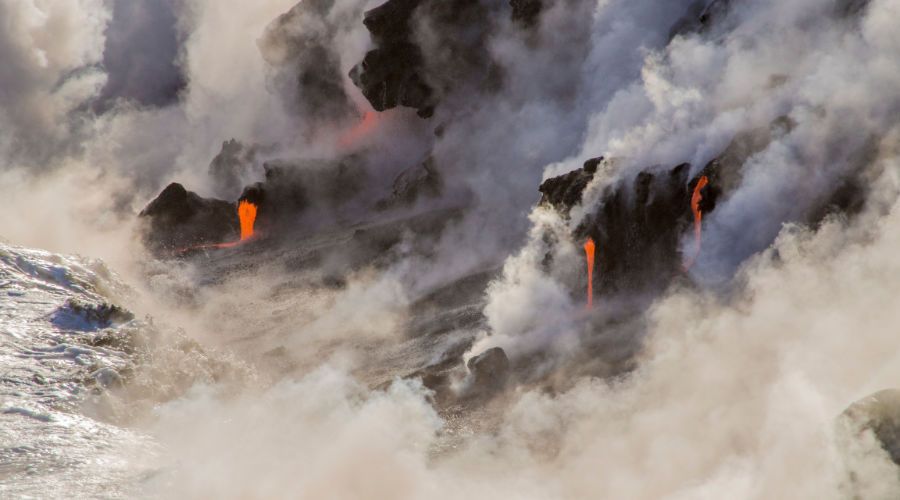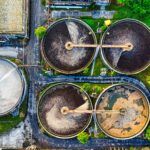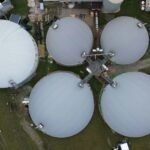Volcanic eruptions are among the planet’s most awe-inspiring natural spectacles. Yet behind the incandescent lava and towering ash columns lies a less visible reality: the effects these emissions have on air qualityAir quality refers to the state of the air we breathe and its composition in terms of pollutants present in the atmosphere. It is considered good when poll...
Read more, health and the environment.
In this article, we explore how volcanoes transform the atmosphere and how technology can help us understand and mitigate their impacts.
Key points
- Eruptions change the air we breathe. They release gases and particles that degrade air quality, reduce visibility and can seriously affect respiratory health.
- Volcanic islands are highly vulnerable zones. Limited atmospheric ventilation favours the build-up of pollutants, especially when natural emissions coincide with human activities.
- Monitoring is key to anticipating risks. Real-time measurement enables informed decisions, protects people and supports safer, more sustainable volcano tourism.
- Technological innovation makes the difference. Kunak AIR Pro stations and the Kunak AIR Cloud platform turn data into insight, helping to understand and reduce the environmental impact of eruptions.
Volcanoes in eruption: lava and more
The La Palma volcano has shown how rapidly atmospheric conditions can change depending on weather and the intensity of volcanic activity. Air quality has become one of the most closely watched environmental indicators, as gas and ash emissions directly affect human health and ecosystems.
Beyond lava, an erupting volcano generates a complex mix of air pollutantsAir pollution caused by atmospheric contaminants is one of the most critical and complex environmental problems we face today, both because of its global r...
Read more that can remain suspended for days or even weeks.
What effect does a volcanic eruption have on air quality?
Volcanic emissions are mainly divided into two categories:
Air Quality Innovation in Just 1 Click
Stay informed about the air you breathe!
Subscribe to our newsletter to receive the latest updates on environmental monitoring technology, air quality studies, and more.
- Suspended particles: ash, volcanic dust, coarse particulate matter (PM10), fine (PM2.5) and ultrafine (PM1).
- Gaseous emissions: sulphur dioxide (SO2)Sulphur dioxide (SO2) is a colourless gas with a pungent odour that causes an irritating sensation similar to shortness of breath. Its origin is anthropoge...
Read more, hydrogen sulphide (H2S), carbon monoxide (CO)The carbon monoxide (CO) is an invisible gas (colorless and odorless) that, at the same time, is a silent killer because in just a few minutes it exhibits ...
Read more, carbon dioxide (CO2)Carbon dioxide (CO2) is a gas that occurs naturally in the atmosphere and plays a crucial role in the life processes of the planet. This gas, also known as...
Read more, methane (CH4)Methane, known chemically as CH₄, is a gas that is harmful to the atmosphere and to living beings because it has a high heat-trapping capacity. For this ...
Read more and volatile organic compounds (VOCs).
These pollutants form what is known as volcanic smogSmog, beyond that dense fog
Smog is a mixture of air pollutants that accumulate in the atmosphere, especially in urban areas. This phenomenon is character...
Read more or vog, a toxic haze that can reduce visibility and cause eye irritation, coughing and respiratory problems.
When lava comes into contact with seawater, chemical reactions release hydrochloric acid (HCl) and corrosive aerosols, increasing risks to health and the environment.
Air quality and volcanic activity on islands
Volcanic islands are particularly vulnerable: limited atmospheric dispersion and stable weather facilitate pollutant accumulation. In addition to natural sources, anthropogenic emissions (transport, agriculture, tourism) further aggravate pollution.
In regions such as the Canary Islands, Hawai‘i, Iceland and the Philippines, studies show that natural volcanic emissions combine with pollutants transported from continental areas, creating a cocktail of gases and particles that degrades air quality and affects local health and biodiversity.
Canary Islands: monitoring the Cumbre Vieja volcano
Studies by the Instituto Tecnológico de Canarias (ITC, 2020) and AEMET reveal that the burning of agricultural and forest residues, combined with episodes of dust haze and Saharan dust intrusions, increases levels of particulate matter (PM10 and PM2.5) and ammonia (NH3)Invisible yet powerful: ammonia (NH3) is a colourless gas which, although naturally present in the atmosphere in small amounts, can become an unwelcome ene...
Read more.
During the Cumbre Vieja eruption, Kunak deployed Kunak AIR Pro stations to monitor gases and particles in real time. These stations, used by the Spanish Military Emergencies Unit (UME), transmitted data to the Kunak AIR Cloud platform, enabling continuous assessment of environmental impact.
The following image also shows the information these devices send to our platform Kunak AIR Cloud.

View of the Kunak AIR Cloud platform during environmental monitoring around the Cumbre Vieja volcano in La Palma (Spain)
The combination of meteorological and air-quality data made it possible to identify critical areas and plan protective measures for residents and emergency personnel.
Volcanoes, tourism and air quality
Volcano tourism has become a form of scientific and nature-based tourism that attracts thousands of visitors each year to destinations such as La Palma, Hawai‘i, Iceland and Sicily. However, air quality near active volcanoes can change dramatically within hours, affecting both visitor safety and local operations.
During eruptions or degassing phases, increased volcanic smog (vog)—a mixture of sulphur dioxide (SO2), fine particles and acidic aerosols—can reduce visibility, affect breathing and cause eye irritation. For this reason, the World Health Organization (WHO) and agencies such as the US Geological Survey (USGS) recommend limiting exposure in areas with high volcanic gas concentrations and keeping the public informed in real time.
In this context, environmental monitoring networks play an essential role. Kunak AIR Pro systems can measure gases and particles in real time, sending data to the Kunak AIR Cloud platform, where dynamic concentration maps and automatic alerts are generated. This information can be shared with local authorities, emergency services and visitors, ensuring preventive and safe management of volcano tourism.
What is more, integrating these tools into geoparks and sustainable-tourism areas adds value to the educational experience, facilitating science communication and promoting a responsible tourism model in which observing the natural power of volcanoes goes hand-in-hand with protecting the environment and public health.
Air-quality sensors and volcanoes: making the invisible visible
Continuous monitoring has become an essential tool for understanding and mitigating the effects of volcanic eruptions.
Kunak AIR Pro stations measure gases and particles with high precision, thanks to remote calibration, real-time alerts and IoT connectivity. These devices complement reference stations and provide immediate data even under extreme conditions.
In La Palma, Kunak sensors proved their effectiveness by recording pollutant trends during the volcanic crisis. Elsewhere, such as at Kīlauea volcano (Hawai‘i), similar projects have quantified the population’s real exposure to volcanic smog and improved emergency management.
The information gathered through these systems strengthens environmental decision-making, protects public health and optimises institutional response to future natural events.
Volcanic emissions and public health
Volcanic emissions are one of the main invisible threats associated with eruptions. Although lava flows often attract media attention, it is the gases and airborne particles that cause the most immediate and lasting impacts on human health.
Volcanoes release a complex combination of sulphur dioxide (SO2), hydrogen sulphide (H2S), carbon monoxide and carbon dioxide (CO and CO2), methane (CH4), fine particles (PM2.5 and PM10) and volatile organic compounds (VOCs). Each of these pollutants acts differently on the body, but they share a common effect: they degrade air quality and reduce respiratory capacity in exposed people.
- Sulphur dioxide (SO2) irritates the respiratory mucosa and may cause lung inflammation and bronchospasms, especially in people with asthma or chronic lung disease.
- Hydrogen sulphide (H2S), easily recognised by its rotten-egg smell, is toxic at high concentrations and can cause dizziness, nausea or even loss of consciousness.
- Fine particles (PM2.5), produced by the fragmentation of volcanic material and by atmospheric chemical reactions, penetrate deep into the lungs, exacerbating respiratory and cardiovascular conditions.
These effects are compounded by indirect impacts on climate and the environment. Greenhouse gasesWhile the concentration of carbon dioxide (CO2) in the atmosphere has been steadily and rapidly increasing in recent decades, in May 2025, CO2 surpassed 43...
Read more, such as CO2 and CH4, contribute to global warming, while volcanic aerosols and VOCs modify solar radiation and reduce visibility, affecting aviation and maritime safety.
In this context, continuous monitoring becomes an essential public-health tool. Smart sensor networks, such as Kunak AIR Pro stations, enable real-time measurement of gas and particle concentrations, issuing early alerts and protecting both the public and field emergency teams.
Accurate, traceable data not only improves emergency management, but also allows the assessment of long-term exposure effects and the design of more effective prevention policies for risks associated with volcanic pollution.
Vean esta casa de dos plantas completamente cubiertas por las cenizas del volcan de la Palma. Solo despuntan sus dos chimeneas. pic.twitter.com/v3buLvsQlJ
— Emilio Morenatti (@EmilioMorenatti) November 7, 2021
Environmental impact of volcanic emissions
Volcanic emissions not only alter air quality; they also have a deep and lasting impact on the global environment. The gases and aerosols expelled into the atmosphere influence climatic, ecological and geochemical processes, altering the natural balance of ecosystems.
Influence on solar radiation and climate
Volcanic aerosols composed of sulphur dioxide (SO2), sulphates and fine ash can reach the stratosphere, where they persist for months or even years. These aerosols reflect part of the solar radiation, causing a temporary cooling of the Earth’s surface and altering atmospheric circulation patterns. The United States Geological Survey (USGS) has documented global temperature reductions after eruptions such as Mount Pinatubo (1991), which lowered the planet’s average temperature by around 0.5 °C.
Deposition of pollutants on soil, water and coastal ecosystems
When volcanic gases react with atmospheric moisture, they generate acid rain that deposits sulphur compounds, nitrates and heavy metals on soils and water bodies. This alters soil chemistry, affects agricultural fertility and accelerates the acidification of surface and coastal waters. The European Environment Agency (EEA, 2022) warns that prolonged deposition of sulphated and nitrated compounds can degrade natural habitats and reduce biodiversity.
Consequences for agriculture, vegetation and biodiversity
In active volcanic regions such as La Palma or Hawai‘i, the fall of fine ash and acidic aerosols directly affects crops, damaging leaves and roots and disrupting photosynthesis. Agricultural soils can become temporarily infertile due to excess salts or metals, while coastal ecosystems are altered by the build-up of sulphates and chlorides. Although, in the long term, ash can enrich soil with minerals, the immediate effect on vegetation is destructive and hampers ecological recovery.
The environmental impact of volcanoes underlines the need to monitor not only air quality, but also the interactions between atmosphere, soil and aquatic ecosystems. Understanding these processes enables more effective mitigation strategies and promotes sustainable management of volcanic environments.
Frequently Asked Questions (FAQs) about air quality and volcanoes
What gases does a volcano emit and how do they affect air quality?
Mainly SO2, H2S, CO2, CH4 and VOCs. These gases react in the atmosphere to form aerosols and secondary particles that degrade air quality and visibility.
What is volcanic smog (vog)?
It is a toxic haze generated by the reaction of SO2 with moisture and other atmospheric compounds. It affects respiratory health and can remain suspended for days.
What effects do volcanic emissions have on human health?
They cause eye and respiratory irritation, persistent coughing and exacerbate diseases such as asthma or bronchitis. At high concentrations, some gases can be toxic.
How is pollution measured in a volcanic environment?
With calibrated IoT sensor networks, such as Kunak AIR Pro, which measure gases and particles in real time, enabling rapid response to changes in air quality.
Why is it important to monitor active volcanoes?
Because it helps anticipate risks, protect the public and obtain scientific data that improve understanding of the atmospheric processes associated with eruptions.
Conclusion
Volcanoes are one of nature’s most powerful forces, but they are also a natural source of air pollution that demands control and understanding.
Continuous, real-time monitoring makes it possible to understand how eruptions affect the atmosphere and public health, turning risk into prevention.
With solutions such as Kunak AIR Pro and Kunak AIR Cloud, it is possible to measure, analyse and act immediately, making science and technology allies of sustainability.









